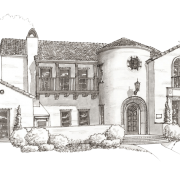Mediterranean vs Spanish Style Homes
Differences Between Mediterranean Style and Spanish Style Homes
The Mediterranean Sea wraps around the lower part of Europe and it includes several countries, including Spain. This area is known for its warm weather, beautiful beaches and vineyards, delightful villages and gorgeous mountain views. The architecture throughout the area shares many of the same features including tall interior ceilings, cool tile floors and lots of windows to bring in fresh breezes. The people of the area also like to decorate both indoors and out with bountiful flower arrangements.
Spanish Style Architecture
Spanish style architecture is an inclusive term that covers several associated styles such as Moorish Revival, Spanish Colonial Revival and Mission Revival. The Spanish style also includes blendings of these styles, where the architecture borrows features from one or more other looks. Local interpretations of this style also alter what is viewed as Spanish, and other styles use Spanish style without sharing the name.
Spanish
Features common to Spanish style design are stucco, adobe or stone facades of a uniform and smooth appearance. Large, sheltered, interior facing courtyards include water features, colorful tile accents, wrought ironwork and niches. Doorways and windows reflect Moorish influences with arches. The style also includes heavy and carved wooden doors with metal work; tile, stone and cobbled floors; and tile and stone roofs. Some adobe style homes also incorporate exposed wood beams and thick, round edged walls with flat roofs.
Mediterranean Style Architecture
Mediterranean style architecture is also an inclusive term that may include Renaissance, Neo Renaissance, Classical, Neo Classical, French Revival, Italian Revival, Mediterranean Revival, Moorish Revival, Mission Revival, Tuscan, Spanish, Vernacular and more. To some extent this style is inclusive of the more Spanish specific style and it will often share features of Spanish architecture. Similar to Spanish style, these variations can also be blended to form local variations on the general Mediterranean style. The term is general with a few common themes.
Mediterranean
Mediterranean style buildings are often more than two stories high with symmetrical features. Some have palladium style windows, columns, low-pitched tile roofs, multiple balconies and lush garden surroundings. Often the doorways will be arched with keystone style details, and the edges of the exterior walls will use a coin treatment. Metal and ironwork are common. The exterior of the building is typically smooth or stone and often a soft tonal color rather than white.
credit – F.R.R.Mallory, Hunker.com



















